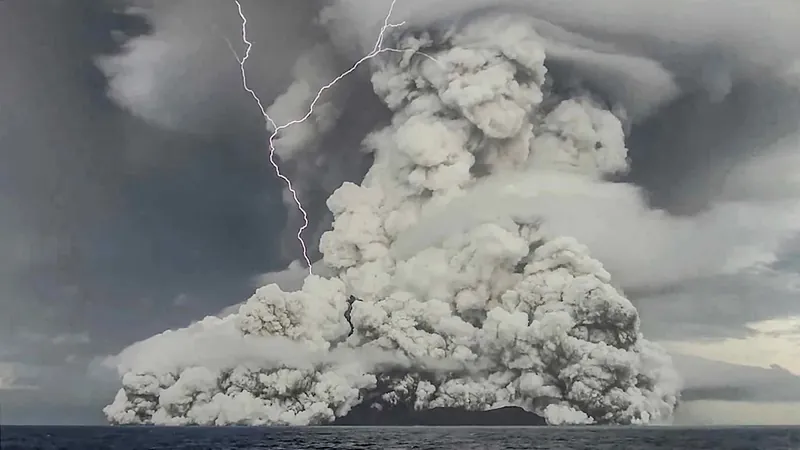
Surprising Findings: Hunga Volcano Eruption Cool Down Southern Hemisphere!
2025-04-03
Author: Wei Ling
Surprising Findings: Hunga Volcano Eruption Cool Down Southern Hemisphere!
In a twist of fate, the explosive eruption of Hunga Tonga–Hunga Ha'apai in January 2022, an underwater volcano located near Tonga in the South Pacific, has led to a cooling effect rather than the anticipated warming of our planet. A thorough investigation led by scientists from UCLA revealed that instead of pushing global temperatures past the critical 1.5°C threshold set by the Paris Agreement, the eruption actually lowered temperatures in the Southern Hemisphere by approximately 0.1°C.
What caused this unexpected cooling?
The eruption released a significant amount of sulfur dioxide that transformed into tiny sulfate aerosols. These smaller particles showcased a remarkable ability to reflect sunlight away from Earth—a process that ultimately outweighed the warming influence of the vast amounts of water vapor that the eruption also released into the stratosphere. Notably, while water vapor is recognized as a greenhouse gas that cools the stratosphere but heats the Earth's surface, the specific interactions between sulfate aerosols and water vapor surprisingly did not lead to the feared rise in global temperatures.
Implications for Future Geoengineering Projects
As UCLA atmospheric scientist Ashok Gupta, the lead author of the study published in Nature Communications Earth and Environment, indicated, this research raises significant implications for future geoengineering projects aimed at combating climate change. The complex relationships between atmospheric components must be understood more deeply to prevent unintended consequences. “If we plan to introduce sulfate aerosols to reflect sunlight, we need to consider how they interact with water vapor and other atmospheric factors,” emphasized Gupta.
Historical Context and Technological Advances
The Hunga Tonga eruption, which occurred from a vent merely 200 meters below the ocean surface, saw vast quantities of water vapor and sulfur dioxide shot into the stratosphere. Historically, similar volcanic events, like the 1991 Mount Pinatubo eruption, have induced cooling effects due to sulfur emissions. However, this time, researchers utilized advanced satellite technology to monitor how water vapor, sulfate aerosols, and ozone distributed in the atmosphere over two years, revealing a cooling trend that caught scientists off-guard.
Fascinating Discoveries about Aerosol Size
What is particularly fascinating is the size of the sulfate aerosols generated by the Hunga eruption. They were about 50% smaller than those produced by the Pinatubo blast, effectively enhancing their capacity to block sunlight. While the Southern Hemisphere enjoyed a cooling effect, there are hints that the Northern Hemisphere may have experienced slight warming due to the lingering water vapor in the stratosphere—pointing to the complex nature of the atmospheric responses.
Conclusion
In conclusion, the Hunga eruption illustrates the intricate interdependencies of atmospheric elements and reminds us that geoengineering solutions to climate change are fraught with uncertainties. Gupta pointed out that the findings assert the need for a comprehensive understanding of atmospheric systems to accurately gauge whether geoengineering measures will yield cooling or warming outcomes.
This research, supported by NASA, the National Science Foundation, and the Simons Foundation, emphasizes the value of scientific inquiry in unraveling the mysteries of our climate system—leading to essential insights about how natural phenomena can both challenge and aid our understanding of climate change.



 Brasil (PT)
Brasil (PT)
 Canada (EN)
Canada (EN)
 Chile (ES)
Chile (ES)
 Česko (CS)
Česko (CS)
 대한민국 (KO)
대한민국 (KO)
 España (ES)
España (ES)
 France (FR)
France (FR)
 Hong Kong (EN)
Hong Kong (EN)
 Italia (IT)
Italia (IT)
 日本 (JA)
日本 (JA)
 Magyarország (HU)
Magyarország (HU)
 Norge (NO)
Norge (NO)
 Polska (PL)
Polska (PL)
 Schweiz (DE)
Schweiz (DE)
 Singapore (EN)
Singapore (EN)
 Sverige (SV)
Sverige (SV)
 Suomi (FI)
Suomi (FI)
 Türkiye (TR)
Türkiye (TR)
 الإمارات العربية المتحدة (AR)
الإمارات العربية المتحدة (AR)